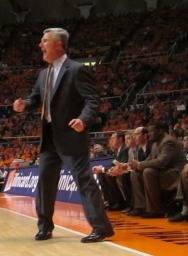 Friday in Jon Corzine Gym* Bruce Weber huddled the team in the corner. On the dry-erase board, he wrote “Osmosis.”
Friday in Jon Corzine Gym* Bruce Weber huddled the team in the corner. On the dry-erase board, he wrote “Osmosis.”
“Who knows what osmosis is?”
Silence.
“Nnanna?”
Nnanna Egwu may be the team’s leading intellectual, but he didn’t offer an answer. Meyers Leonard volunteered “microbiology.”
Weber was teaching a lesson about instincts. He began with some concrete examples. Players shooting 8% from three should consider abandoning the long ball. But rebounding will keep a guy in the rotation. Know your place on the floor, and your place on the team. That was the message.
Then Weber waxed philosophical. His voice calm, even gentle. No late-season rasp. He described cell division, noting that osmosis helps neighboring cells share components. You put the rebounders and the shooters together, and you get a stronger eukaryote.
Weber wisely avoided the primary function of osmosis, which is for one cell to carry water to another.
Bruce Weber’s Philosophy of Offense leaves the particulars out, and asks the individual player to see the game around him. It’s about recognizing one’s placement on the floor, the spacing of the nine other guys on it, and the opportunities created by that arrangement: weaknesses available for exploitation.
 In the Age of Deron, basketball aficionados drooled praise for the Poetry in Weber’s Motion. In the years since, Weber’s Zen basketball yielded sentence fragments. It didn’t take long for the system to break down. In 2006, we watched Dee Brown dribble for 34 seconds before chucking a long three-point attempt. It took a lot longer for perception to converge with reality. Weber led Illinois to its best season record since The Great War. People saw those results. They gave him the benefit of the doubt. Over the next five years, as the Illini compiled a .500 record in Big Ten play, believers increasingly turned agnostic. When hapless Indiana beat the Illini last winter, the long knives unsheathed. Something snapped.
In the Age of Deron, basketball aficionados drooled praise for the Poetry in Weber’s Motion. In the years since, Weber’s Zen basketball yielded sentence fragments. It didn’t take long for the system to break down. In 2006, we watched Dee Brown dribble for 34 seconds before chucking a long three-point attempt. It took a lot longer for perception to converge with reality. Weber led Illinois to its best season record since The Great War. People saw those results. They gave him the benefit of the doubt. Over the next five years, as the Illini compiled a .500 record in Big Ten play, believers increasingly turned agnostic. When hapless Indiana beat the Illini last winter, the long knives unsheathed. Something snapped.
In the past, when observing a foundering offense, I’ve suggested that Weber can’t rely on Zen principles and underclassmen. It’s one or the other, because new guys in the Petri dish don’t have enough time to absorb the mitochondria of motion.
STRICT TEMPO
There’s an important codicil to this rule. It applies only to the half-court grind. Full court, up-tempo offense — and the fastbreak opportunities created by pressure defense — simply don’t allow for stagnation of motion. If the Illini resist the tendency to “make the defense work” by nursing the shot clock, running meaningless routes, not seizing available opportunities; this 2012 Illini team can immunize itself from the troubles of five long years.
Even if these Illini don’t win all their games, fans will have more fun watching them play at speed. It’s not just the losing that made 11,000 seats available for last week’s exhibition game. It’s losing 38–33. Only soccer fans and basketball coaches like watching defensive struggles. The casual fan prefers a highlight reel.
Case in point: Dick Bennett got his Wisconsin club to the Final Four by plodding through. Contrast Tom Davis, who never got Iowa past the Elite Eight. I’d much rather watch Iowa’s full-court press, and quirky offensive sets. Watching Bennett-ball hurt. The constant wincing expression on Bennett’s face seemed contagious. I certainly caught it.
Davis played a long bench, to keep players fresh.The long bench is not absolutely necessary for up-tempo play, but it includes the benefit of keeping players mentally involved. When a team devolves into players and sitters, haves and have-nots; enmity ensues, osmosis ends. Team chemistry breaks down. The organic unit divides. Individual parts no longer feed the whole. They’re locked in their own cells.
Bruce Weber’s pre-season pronouncements indicate a willingness to play up-tempo. But we’ve heard him say that before. Will it be different this time? Can Bruce Weber change his spots? When the pressure’s on, will he remember his resolutions? Weber’s understanding of osmosis is the key to unlocking the potential in this team. Be encouraged that he’s preaching this gospel. It just might work.
Monday night, we might get a better glimpse of the team. i.e. if Sam Maniscalco and Myke Henry play in the exhibition against Quincy, we’ll see a more representative version of Illinois 2012.
Let’s assume Weber’s only joking about his nephew. Austin Weber plays for Quincy. Weber said he’d run a box-and-one (zone defense with a singular defender attached to Austin at the hip) to keep Austin from scoring. But of course, what Weber really wants to do is run his game plan, to see whether he can live with it when the games start counting.
*I’ve been getting it wrong this whole time. The Ubben & Corzine Complex is divided into two parts. The women’s gym is referred to as “1” and the men’s “2.” Thus, I conclude that the former is Ubben and the latter is Corzine.








